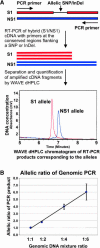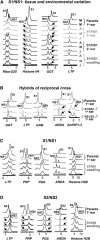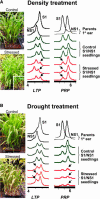Allelic variation of gene expression in maize hybrids
- PMID: 15194819
- PMCID: PMC514155
- DOI: 10.1105/tpc.022087
Allelic variation of gene expression in maize hybrids
Abstract
Allelic expression variation of nonimprinted autosomal genes has recently been uncovered in mouse hybrids and humans. The allelic expression variation is attributed to differences in noncoding DNA sequences and does not involve epigenetic regulation or gene imprinting. This expression variation is suggested to play important roles in determining phenotypic diversity. Virtually nothing is known about such allele-specific expression variation in a hybrid plant where two alleles are compared in the same genetic context. We examined parental transcript accumulation in maize (Zea mays) hybrids using allele-specific RT-PCR analysis. Among 15 genes analyzed, 11 showed differences at the RNA level, ranging from unequal expression of the two alleles (biallelic) to expression of a single allele (monoallelic). Maternal or paternal transmission had little effect on the allele-specific transcript ratio of nearly all genes analyzed, suggesting that parent-of-origin effect was minimal. We analyzed the allelic difference in genetically contrasting hybrids and hybrids under high planting density and drought stress. Whereas a genetically improved modern hybrid expressed both alleles, a less improved old hybrid frequently showed mono-allelic expression. Furthermore, the two alleles in the hybrid responded differentially to abiotic stresses. The results of allele-specific regulation in different tissues in responding to environment and stress suggest an unequivalent function of the parental alleles in the hybrid, which may have an impact on heterosis.
Figures



References
-
- Altschul, S.F., Gish, W., Miller, W., Myers, E.W., and Lipman, D.J. (1990). Basic local alignment search tool. J. Mol. Biol. 215, 403–410. - PubMed
-
- Bhattramakki, D., Dolan, M., Hanafey, M., Wineland, R., Vaske, D., Register, J.C., III, Tingey, S.V., and Rafalski, A. (2002). Insertion-deletion polymorphisms in 3′ regions of maize genes occur frequently and can be used as highly informative genetic markers. Plant Mol. Biol. 48, 539–547. - PubMed
-
- Buckler, E.S., and Thornsberry, J.M. (2002). Plant molecular diversity and applications to genomics. Curr. Opin. Plant Biol. 5, 107–111. - PubMed
MeSH terms
Associated data
- Actions
- Actions
- Actions
- Actions
- Actions
- Actions
- Actions
- Actions
- Actions
- Actions
- Actions
- Actions
- Actions
LinkOut - more resources
Full Text Sources
Other Literature Sources

